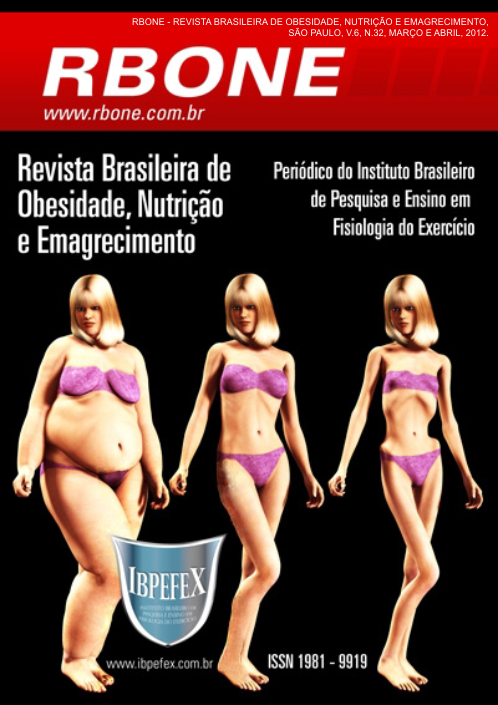Training aerobic: perspectives about intensities returned to the weig loss in adolescentes
Abstract
The obesity in the last 25 years is an epidemic that grows so much at the developed countries as in the countries in development. With that, the concern with the health and decrease of the own obesity receives prominence in the areas returned to the treatment and prevention of the disease. The physical exercise, wins your space and more and more it is indicated as measure it executes in the treatment and decrease of the corporal fat. The present study makes a revision among the bases of data you inform considered, looking for explanations on which intensity worked in the exercise aerobic makes possible larger fat consumption as energy substratum in the search for the weigh loss. It is ended that studies with relationship to intensities, duration and training types should be deepened, therefore, in several works and studies here mentioned the researchers they arrived to positive results generating divergences in the methodology, intensities, duration, training types and results found in the works.
References
-Abrantes, M. M.; Lamounier, J. A.; Colosimo, E. A . Prevalência de sobrepeso e obesidade em crianças e adolescentes das regiões Sudeste e Nordeste. Jornal de Pediatria. Vol. 78. Núm. 4. 2002.
-American College of Sports Medicine (ACSM). Position stand: proper and improper weight loss programs. Medicine and Science in Sports and Exercise. Madison. Vol.15. p. 9-13. 1983.
-Ballor, D.L.; Harvey-berino, J.R.; Ades, P.A.; Cryan, J.; Calles-Escandon, J. Contrastingeffects of resistance and aerobic training on body composition and metabolism after diet-induced weight loss. Metabolism. Philadelphia. Vol. 45. p. 179-83. 1996.
-Campos, M.A. Musculação: diabéticos, osteporóticos, idosos, crianças, obesos. Rio de Janeiro. Sprint. 2001.
-Caprio, S.; Tamborlane, W. V. Metabolic impact of obesity in childhood. Pediatric of Endocrinology. Vol. 28. Núm. 4. p. 731-747. 1999.
-Colégio Americano de Medicina do Esporte. Diretrizes do ACSM para os testes e esforço e sua prescrição. Rio de janeiro. Guanabara Koogan. 2003.
-Dengel, D.R.; Hagberg, J.M.; Pratley, R.E.; Rogus, E.M.; Goldberg, A.P. Improvements in blood pressure, glucose metabolism, and lipoprotein lipids after aerobic exercise plus weight loss in obese, hypertensive middle-aged men. Metabolism. Philadelphia. Vol. 47. p. 1075-82. 1998.
-Fernandez, A.C.; Mello, M.T.; Tufik, S.; Castro, P.M.; Fisberg, M. Influência do treinamento aeróbio e anaeróbio na massa de gordura corporal de adolescentes obesos. Rev bras med esporte. Vol. 10. Núm. 3. p. 152-158. 2004.
-Guedes, D.P.; Guedes, J.E.R.P. Controle do peso corporal; composição corporal, atividade física e nutrição. Rio de Janeiro. Shape. 2003.
-Gwinup, G. Effectof exercise alone on the weitht of obese women. Archives of Internal medicine. Chicago. Vol. 135. p. 676-80. 1975.
-Lederer, J. Enciclopédia Moderna de Higiene Alimentar. São Paulo. Manole. 1991.
-Martin, W.H. Effect of endurance training on fatty acid metabolism during whole body exercise. Medicine and Science in Sports and Exercise. Madison. Vol. 29. p. 635-9. 1997.
-Melby, C.L.; Commerford, S.R.; Hill, J.O. Exercise, macronutrient balance, and weight control. In: Lamb, D.R.; Murray, R. Perspectives in exercise science and sportsmedicine: exercise, nutrition, and weight control. Carmel. Cooper Publ Group. Vol. 11. p. 1-60. 1998.
-Monteiro, R.C.A.; Riether, P.T.A.; Burini, R.C. Efeito de um programa misto de intervenção nutricional e exercício físico sobre a composição corporal e os hábitos alimentares de mulheres obesas em climatério. Rev nutr. Vol. 17. Núm. 4. p. 479-489. 2004.
-Nahás, M.V. Atividade física, saúde e qualidade de vida: conceitos e sugestões para um estilo de vida mais ativo. Londrina. Midiograf. 2001.
-Nahás, M.V. Obesidade, controle de peso e atividade física. Londrina. Midiograf. 1999.
-Nieman, D. Exercício e saúde. São Paulo. Manole. 1999.
-Oliveira, C.l.; Fisberg, M. Obesidade na infância e adolescência uma verdadeira epidemia. Arq bras endocrinol metab. Vol. 47. Núm. 2. p. 107-108. 2003.
-Phelain, J.F.; Reinke, E.; Harris, M.A.; Melby, C.L. Post exercise energy expanditure and substrateoxdation in young women resulting from exercise bouts of different intensity. Journal of American College of Nutrition. Brooklyn. Vol. 16. p. 140-6. 1997.
-Popkin, B.M.; Doak, C.M. The obesity epidemic is a worldwide phenomenon. Nutrition Reviews. Washington. Vol. 56. p. 106-14. 1998.
-Sabia, R.V.; Santos, J.E.; Ribeiro, R.P.P. Efeito da atividade física associada à orientação alimentar em adolescentes obesos: comparação entre o exercício aeróbio e anaeróbio. Rev bras med esporte. Vol. 10. Núm. 5. p. 349-355. 2004.
-Sociedade Brasileira de Cardiologia -SBC. Programa nacional de prevenção e epidemiologia. Disponível em: . Acessado em: 14/08/2008.
-Thompson, D.L.; Townsend, K.M.; Boughey, R.; Patterson, K.; Bassett Junior, D.R. Substrate use during and following moderate-and lowintensity exercise: implications for weight control. European Journal of Applied Physiology. Berlin. Vol. 78. p. 43-9. 1998.
-Villares, S.M.F.; Ribeiro, M.M.; Silva, A.G. Obesidade infantil e exercício, Revista Abeso. 2003. Disponível em: http: www.abeso.org.br/revista/revista13/obes infantil.htm. Acessado em 03/06/2008.
-World Health Organization -WHO. Obesity: preventing and managing the global epidemic. Geneva. 1998.
-Wimore, J.K.; Costil, D. L. Physiology of sport and exercise.Human Kinetics. 1994.
Authors who publish in this journal agree to the following terms:
- Authors retain the copyright and grant the journal the right of first publication, with work simultaneously licensed under the Creative Commons Attribution License BY-NC which allows the sharing of the work with acknowledgment of the authorship of the work and initial publication in this journal.
- Authors are authorized to enter into additional contracts separately for non-exclusive distribution of the version of the work published in this journal (eg, publishing in institutional repository or book chapter), with acknowledgment of authorship and initial publication in this journal.
- Authors are allowed and encouraged to post and distribute their work online (eg, in institutional repositories or on their personal page) at any point before or during the editorial process, as this can bring about productive change as well as increase impact and impact. citation of published work (See The Effect of Free Access).






